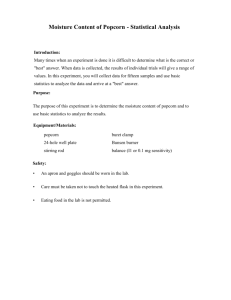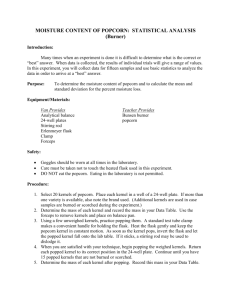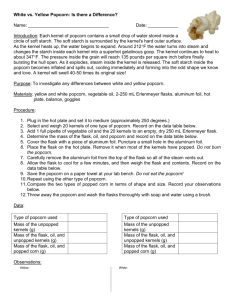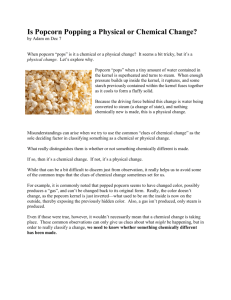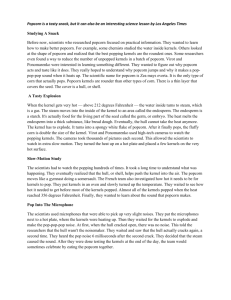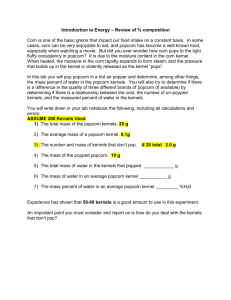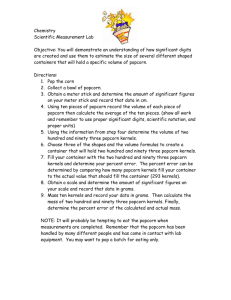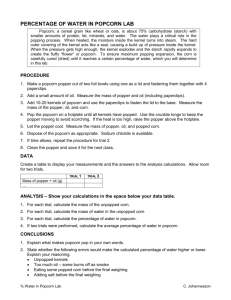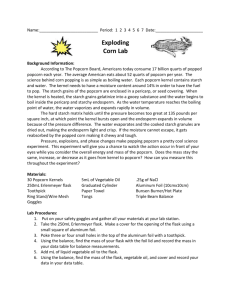14 Popcorn
advertisement
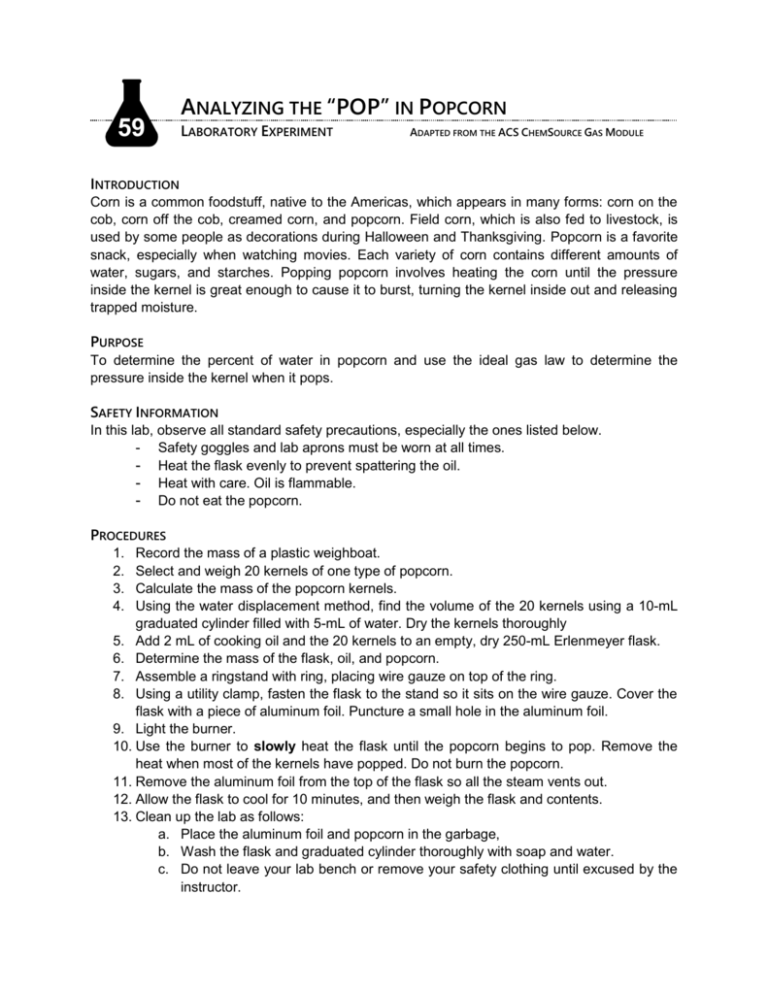
59 ANALYZING THE “POP” IN POPCORN LABORATORY EXPERIMENT ADAPTED FROM THE ACS CHEMSOURCE GAS MODULE INTRODUCTION Corn is a common foodstuff, native to the Americas, which appears in many forms: corn on the cob, corn off the cob, creamed corn, and popcorn. Field corn, which is also fed to livestock, is used by some people as decorations during Halloween and Thanksgiving. Popcorn is a favorite snack, especially when watching movies. Each variety of corn contains different amounts of water, sugars, and starches. Popping popcorn involves heating the corn until the pressure inside the kernel is great enough to cause it to burst, turning the kernel inside out and releasing trapped moisture. PURPOSE To determine the percent of water in popcorn and use the ideal gas law to determine the pressure inside the kernel when it pops. SAFETY INFORMATION In this lab, observe all standard safety precautions, especially the ones listed below. - Safety goggles and lab aprons must be worn at all times. - Heat the flask evenly to prevent spattering the oil. - Heat with care. Oil is flammable. - Do not eat the popcorn. PROCEDURES 1. 2. 3. 4. Record the mass of a plastic weighboat. Select and weigh 20 kernels of one type of popcorn. Calculate the mass of the popcorn kernels. Using the water displacement method, find the volume of the 20 kernels using a 10-mL graduated cylinder filled with 5-mL of water. Dry the kernels thoroughly 5. Add 2 mL of cooking oil and the 20 kernels to an empty, dry 250-mL Erlenmeyer flask. 6. Determine the mass of the flask, oil, and popcorn. 7. Assemble a ringstand with ring, placing wire gauze on top of the ring. 8. Using a utility clamp, fasten the flask to the stand so it sits on the wire gauze. Cover the flask with a piece of aluminum foil. Puncture a small hole in the aluminum foil. 9. Light the burner. 10. Use the burner to slowly heat the flask until the popcorn begins to pop. Remove the heat when most of the kernels have popped. Do not burn the popcorn. 11. Remove the aluminum foil from the top of the flask so all the steam vents out. 12. Allow the flask to cool for 10 minutes, and then weigh the flask and contents. 13. Clean up the lab as follows: a. Place the aluminum foil and popcorn in the garbage, b. Wash the flask and graduated cylinder thoroughly with soap and water. c. Do not leave your lab bench or remove your safety clothing until excused by the instructor. DATA TABLE Brand of popcorn used Mass of the weighboat (g) Mass of the kernels and the weighboat (g) Volume of water (mL) Volume of water and kernels (mL) Mass of the flask, oil, and kernels (g) Mass of the flask, oil, and popped corn (g) CALCULATIONS 1. 2. 3. 4. 5. Calculate the mass of the kernels in grams. Calculate the volume of the kernels in liters. Calculate the mass of water lost from the popcorn. Calculate the percent of water in the popcorn. Calculate the pressure of the steam inside the kernel which caused the “pop” using the Ideal Gas Law. Hints: Convert the mass of water lost into mols of water o Use R = 0.0821 (atm L)/(mol K) o Assume that the popcorn pops at the boiling point of the cooking oil (225C) o You’ll need to divide the final answer by 20, since we want the pressure per kernel and you used 20 kernels. QUESTIONS 1. Is the pressure inside the popcorn kernels just before it pops greater than or less than atmospheric pressure? 2. What is the purpose of using cooking oil when making popcorn? 3. How does heating popcorn affect the pressure inside the popcorn?
